What’s in a name?
That which we call a rose
By any other name
Would smell as sweet
William Shakespeare, Romeo and Juliet
There was a time when only physicians and medical students knew the name “Crohn.’” Even if you are only a casual watcher of commercial television you may have seen one of the various advertisements for medications used to treat Crohn’s disease. Crohn’s disease is a chronic inflammatory condition, likely to be autoimmune in nature, principally involving the intestines. At first thought to be limited to the distal small intestine (“terminal ileitis”) it became apparent that potentially any part of the small and large intestines can be involved, as well as other organs. Crohn’s disease has a number of potentially life-threatening complications. At one time, surgery was the principal therapy but that was abandoned many years ago in favor of medical therapy which has increasingly become more effective and more varied.
medications used to treat Crohn’s disease. Crohn’s disease is a chronic inflammatory condition, likely to be autoimmune in nature, principally involving the intestines. At first thought to be limited to the distal small intestine (“terminal ileitis”) it became apparent that potentially any part of the small and large intestines can be involved, as well as other organs. Crohn’s disease has a number of potentially life-threatening complications. At one time, surgery was the principal therapy but that was abandoned many years ago in favor of medical therapy which has increasingly become more effective and more varied.
In addition to anti-diarrheals, antibiotics and anti-inflammatory agents, such as corticosteroids and other therapies, a number of molecular-based remedies have been applied, with significant success. These include agents that suppress or otherwise target specific proteins made by the immune system (“biologics”).
This essay will not specifically consider the manifestations, pathogenesis, diagnosis or treatment for Crohn’s disease but will, instead, concentrate on how this uncommon, but not rare, disorder came to be recognized. We will briefly consider the history of Crohn’s disease and whether or not it has the right name.
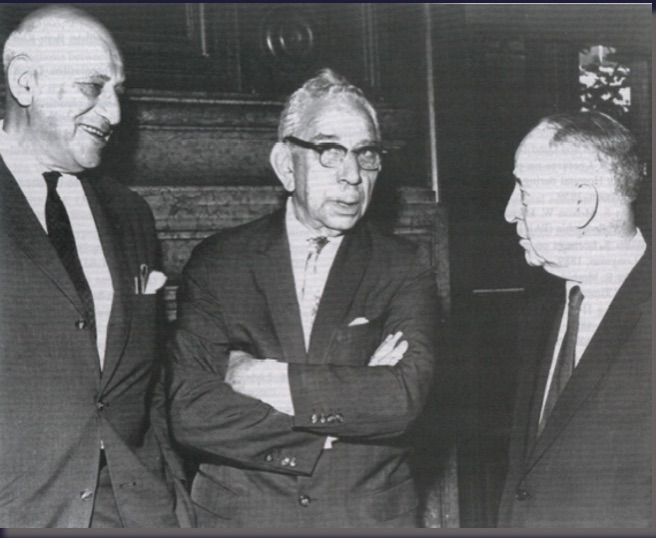
Oppenheimer, Crohn, Ginzburg
In 1932, three physicians at The Mount Sinai Hospital in New York (Burrill B. Crohn, a busy gastroenterologist, Leon Ginzburg, a brilliant surgeon, and Gordon Oppenheimer, then a fellow in pathology but later a urologist) published a paper about a distinctly uncommon inflammatory intestinal disease mostly involving a portion of the last part of the small intestine (the ileum).
The title of their paper was “Regional Ileitis: a 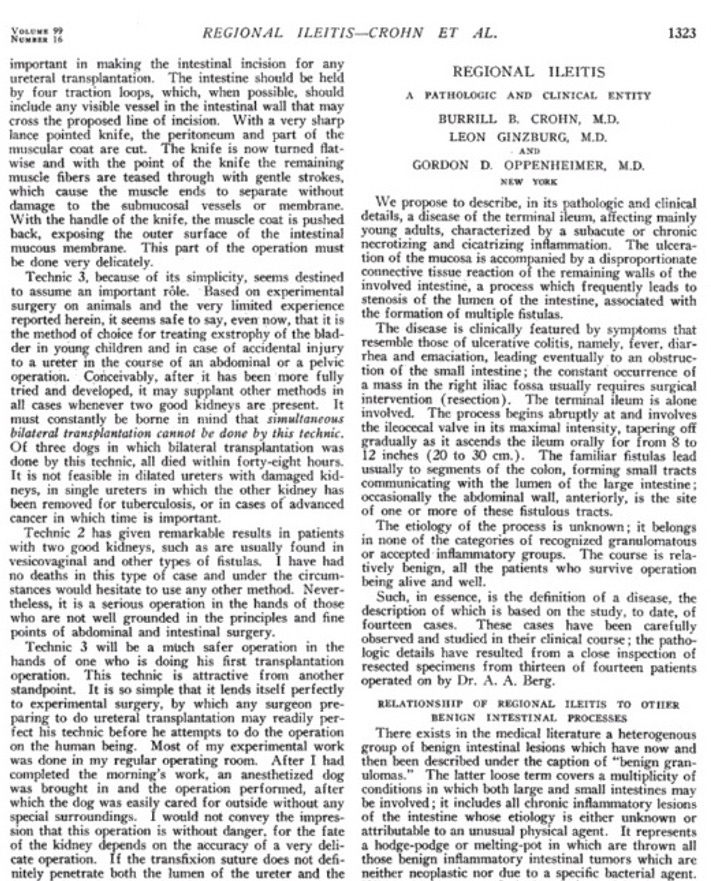 pathologic and clinical entity.” The infiltrate of inflammatory cells seen with the microscope was unusual in that it consisted of granulomas (a nodular cluster of chronic inflammatory cells, such as lymphocytes and other mononuclear cells and, often, multinucleated giant cells, generally without necrosis). Some years later the term “Crohn’s disease” was used in a presentation at a medical meeting and then in a publication. The name persisted for a number of reasons, including because the etiology, which might provide a more scientific name, is still unknown.
pathologic and clinical entity.” The infiltrate of inflammatory cells seen with the microscope was unusual in that it consisted of granulomas (a nodular cluster of chronic inflammatory cells, such as lymphocytes and other mononuclear cells and, often, multinucleated giant cells, generally without necrosis). Some years later the term “Crohn’s disease” was used in a presentation at a medical meeting and then in a publication. The name persisted for a number of reasons, including because the etiology, which might provide a more scientific name, is still unknown.
Other names, such as “regional ileitis” and “granulomatous enteritis,” were applied and abandoned because they did not accurately reflect the disorder or because they were not specific enough. The disease is not limited to the ileum or even the small intestine, as was taught for many years, but can also affect the large intestine, the stomach and, when adjacent to an affected portion of the intestine, other abdominal organs and structures.
The appellation “Crohn’s disease” didn’t satisfy all of the authors of the 1932 paper. Ginzburg, listed second, never used that label because he thought he, of the three, had made the major contribution to the study. However, in keeping with the style of the times, this medical journal required authors to list their names in alphabetical order.
The name “Crohn” became known throughout the world in 1956, when Dwight D. Eisenhower was afflicted with Crohn’s disease. At that time Eisenhower was the 34th President of the United States. He had been the principal architect of the June 6, 1944 invasion of Europe that was key to defeating Nazi Germany and eventually ending World War II.

note white terminal ileum in surgeon’s sketch
Crohn was one of those asked to comment on the case. He said the President had a relatively mild form of the disorder and predicted that Eisenhower would do very well after surgical resection of the affected terminal ileum
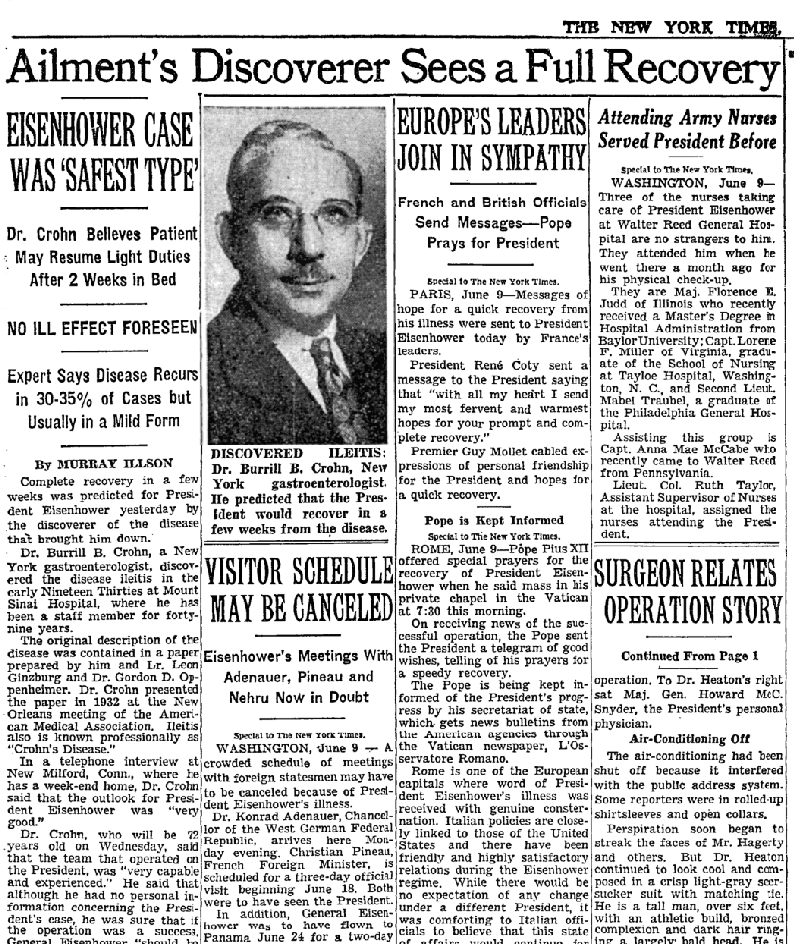
Eisenhower did, indeed, recover completely, although he required intestinal resection 13 years later because of adhesions developed subsequent to the original surgery.
Eisenhower’s illness, treatment and subsequent course became known worldwide and the disease, and its eponym, became well known to the general public on every continent. The overwhelming majority of the many millions who read about Eisenhower’s affliction in newspapers or saw reports on television had never heard of the condition before.
But Eisenhower was not the first person to have this disorder. And Crohn and his colleagues were not the first to observe it. Crohn’s disease was described millenia before the 20th century.
[A slight diversion. Three or more decades ago, a number of leading medical journals, as well as medical dictionaries, abandoned the use of the possessive apostrophe-s for eponyms since the persons whose names were used (e.g., Crohn, Hodgkin, Bright, Addison, Alzheimer to Zenker, etc) did not themselves have the disorder. Very few eponyms (e.g. Lou Gehrig’s disease, Hartnup’s disease, Mortimer’s disease) actually refer to the affected individual. For the rest of this discussion, we will use the non-possessive form and refer to Crohn disease.]
the possessive apostrophe-s for eponyms since the persons whose names were used (e.g., Crohn, Hodgkin, Bright, Addison, Alzheimer to Zenker, etc) did not themselves have the disorder. Very few eponyms (e.g. Lou Gehrig’s disease, Hartnup’s disease, Mortimer’s disease) actually refer to the affected individual. For the rest of this discussion, we will use the non-possessive form and refer to Crohn disease.]
A number of descriptions, from ancient writings, of individuals afflicted with diarrheal disorders could well represent Crohn disease. Indeed, in ancient times, it was once mistakenly supposed that all diseases started as intestinal inflammation.
In the 1st century, the great physician Aretaeus of Cappodicia, in Asia Minor, then a part of ancient Greece and now in Turkey, described young people with recurrent, painful diarrheal illnesses. Although his description was relatively limited, the condition he saw and wrote about was most likely Crohn disease.
The next significant documentation of what was likely Crohn disease  involved Alfred the Great (848/9-26 October 899), the warrior king of England, who lived two or more centuries after King Arthur (He is our King – the life and death of King Arthur over the ages – http://www.stephenageller.com/2019/10/03/he-is-our-king-t…through-the-ages/ and Journey to Podstrana – the search for King Arthur continues – http://www.stephenageller.com/2019/10/20/journey-to-podstrana-the-search-for-arthur-continues/).
involved Alfred the Great (848/9-26 October 899), the warrior king of England, who lived two or more centuries after King Arthur (He is our King – the life and death of King Arthur over the ages – http://www.stephenageller.com/2019/10/03/he-is-our-king-t…through-the-ages/ and Journey to Podstrana – the search for King Arthur continues – http://www.stephenageller.com/2019/10/20/journey-to-podstrana-the-search-for-arthur-continues/).
In contrast to Arthur, Alfred’s life is well documented. He served as king of the West Saxons from 871-886 and king of the Anglo-Saxons from 886-899) and is most renowned for resettling the Roman city of London, in 886, after its abandonment by the Saxons, in the area now known as the Strand. Alfred created a harbor and a market in 899 to restore the city after Viking invasions, beginning the development of the great city we know today. He also made laws for the benefit of the people, rather than the privileged, and believed education was important. Alfred mandated the translation of books from Latin to English so they could be read by as many people as possible.
At the celebration of his marriage to Ealshswith, of Mercia, King Alfred “… was struck without warning … by a sudden severe pain that was quite unknown to all physicians.” This affliction was chronic, continuing “for many years without remission, from his twentieth year up to his fortieth and beyond.” Asser, a contemporary of Alfred, gave a picture of a stricken monarch who suffered almost unremittingly from his symptoms but who, despite this, was able to pursue matters of state. Asser particularly noted that Alfred’s illness was intermittent, as Crohn disease often is.
Autopsies were rarely performed at that time and the precise nature of Alfred’s ailment is not known but the clinical events match those of someone with Crohn disease. Three centuries later it was not unusual for kings of England to be “dissected.” As one example, the body of the sadistic King John, of both Magna Carta and Robin Hood fame and brother of Richard the Lion Heart, was dissected after he died of an acute intestinal disorder, perhaps due to dysentery or possibly after poisoning.
In the 15th century, Antonio Benivieni (1443-1503), of Florence, Italy, one of the pioneers in the use of the autopsy in medical practice, studied a patient with “… gripes in the intestines … apt to ulcerate the lining …” who had wasting and likely died with Crohn disease.
King Louis XIII of France (1601-1643) had attacks of diarrhea for  decades. He had bloody diarrhea, abdominal pain and developed a perianal fistula/abscess, a known complication of Crohn disease. When he died, autopsy disclosed ulcers of the small and large bowel and the perianal involvement. He also had a cavitary lesion of the lung which could have been tuberculosis. Tuberculosis can affect the intestines, but this was unlikely, in Louis XIII’s case, to be related to the intestinal disorder which he had for decades. In the 17th century people with tuberculosis did not live for decades and the king most likely became infected just before he died.
decades. He had bloody diarrhea, abdominal pain and developed a perianal fistula/abscess, a known complication of Crohn disease. When he died, autopsy disclosed ulcers of the small and large bowel and the perianal involvement. He also had a cavitary lesion of the lung which could have been tuberculosis. Tuberculosis can affect the intestines, but this was unlikely, in Louis XIII’s case, to be related to the intestinal disorder which he had for decades. In the 17th century people with tuberculosis did not live for decades and the king most likely became infected just before he died.
Giovanni Battista Morgagni (1682-1771), one of the greatest physicians  in the history of medicine, promoted the correlation of autopsy observations with the preceding clinical history and physical findings documented during life.
in the history of medicine, promoted the correlation of autopsy observations with the preceding clinical history and physical findings documented during life.
His great book, De Sedibus et Causis Morborum (the sites and cause of disease), established the firm foundation of modern medicine and included a typical description of Crohn disease when he wrote about a 20-year-old man with “erosions, ulceration and perforation of the extremity of the ileum and the nearest point of the colon to the extent of two hands breadth” – what would later be termed “regional ileocolitis.” The list of Morgagni’s contributions to our knowledge is unmatched and includes descriptions of angina pectoris, coronary artery disease, infection of the valves of the heart, aneurysm, pneumonia, tuberculosis, cirrhosis of the liver, aortic and central nervous system syphilis, gastric carcinoma, colonic carcinoma, ulcerative colitis, stroke, and literally many dozens of other conditions. Notably, he was also a highly regarded and prolific poet.
In the years after Morgagni other physicians, including Matthew Baillie (1761-1823), Jean Cruvelhier (1791-1874) and Samuel Wilks (1824-1911) described other cases of typical Crohn disease. In 1889, E. Hurry Fenwick (1856-1944) wrote about a 27-year-old woman with a long history of diarrhea and weight loss in whom “… many of the coils of the intestine were adherent and communication existed between …” two different segments of the small intestine. The lower part of the ileum, greatly dilated and thickened, was immediately before the area of the junction of the small and large intestine which was “contracted to the size or a swan’s quill.” Thickened bowel wall, because of inflammation involving all intestinal layers with narrowing (stenosis) of the lumen causing obstruction, is a characteristic pattern of Crohn disease.
In 1913, two decades before the Crohn paper, T. Kennedy Dalziel (1861- 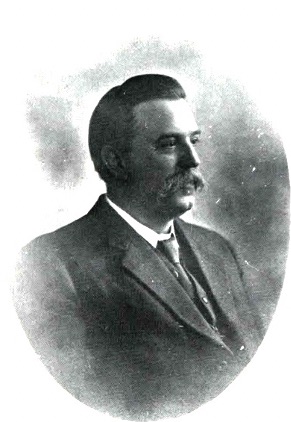 1924), a brilliant surgeon and pathologist in Glasgow, Scotland, wrote a paper (“Chronic Interstitial Enteritis”) that clearly identifies the disease we now identify with Crohn. Dalziel was probably the first to understand its nature as a unique entity. Many, in the United Kingdom, believe Dalziel’s name should be attached rather than Crohn’s.
1924), a brilliant surgeon and pathologist in Glasgow, Scotland, wrote a paper (“Chronic Interstitial Enteritis”) that clearly identifies the disease we now identify with Crohn. Dalziel was probably the first to understand its nature as a unique entity. Many, in the United Kingdom, believe Dalziel’s name should be attached rather than Crohn’s.
Ten years after Dalziel, and still ten years before Crohn, Eli Moschcowitz (1882-1964), an internist and pathologist also working at New York’s The Mount Sinai Hospital, reported on “Nonspecific Granulomata of the Intestine.” He, as did Dalziel before him, recognized that he was describing a distinctive disorder. Moschcowitz’s name has also been immortalized with the 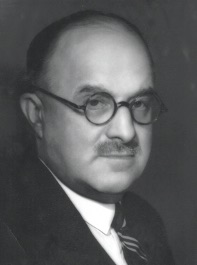 eponym “Moschcowitz disease” (thrombotic thrombocytopenia purpura or TTP, one of the family of autoimmune conditions known, at one time, as the collagen-vascular disorders. These entities were first understood by Paul Klemperer, as discussed below.
eponym “Moschcowitz disease” (thrombotic thrombocytopenia purpura or TTP, one of the family of autoimmune conditions known, at one time, as the collagen-vascular disorders. These entities were first understood by Paul Klemperer, as discussed below.
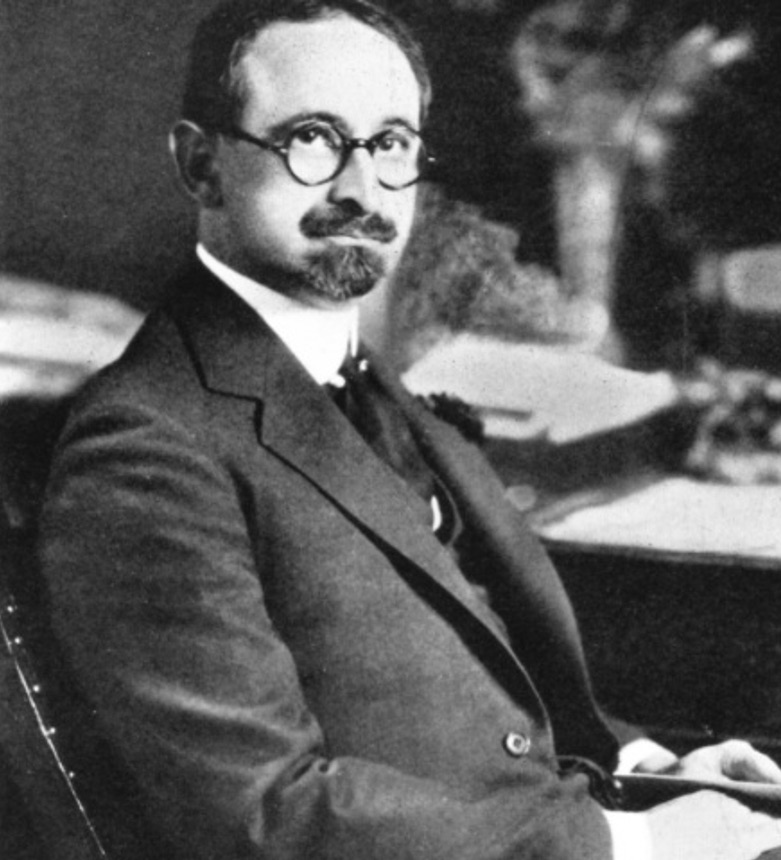 The impetus for the Crohn publication seems to have come from A.A. Berg (1872-1950), former student of Billroth in Vienna (see Medical Trivia #4: Billroth and Brahms – http://www.stephenageller.com/2019/03/06/medical-trivia-4-billroth-and-brahms/) and Chief of Surgery at Mount Sinai. It is not entirely clear who contributed all of the patients for the 1932 paper, but Berg apparently had five of them. He encouraged Ginzburg, his associate in Surgery and Oppenheimer, then a resident in surgical pathology, to put together the data as a scientific report. Crohn had three additional patients. Berg, whose name would have come first in any publication emanating from the group, refused to put his name on any publication that included other authors, hence Crohn, next alphabetically, became the senior author and, soon after, the eponym for the disease.
The impetus for the Crohn publication seems to have come from A.A. Berg (1872-1950), former student of Billroth in Vienna (see Medical Trivia #4: Billroth and Brahms – http://www.stephenageller.com/2019/03/06/medical-trivia-4-billroth-and-brahms/) and Chief of Surgery at Mount Sinai. It is not entirely clear who contributed all of the patients for the 1932 paper, but Berg apparently had five of them. He encouraged Ginzburg, his associate in Surgery and Oppenheimer, then a resident in surgical pathology, to put together the data as a scientific report. Crohn had three additional patients. Berg, whose name would have come first in any publication emanating from the group, refused to put his name on any publication that included other authors, hence Crohn, next alphabetically, became the senior author and, soon after, the eponym for the disease.
Who really understood the disease and where did the remaining six patients reported in the 1932 paper which described a total of 14 individuals come from?
Paul Klemperer (1887-1964) was Mount Sinai’s Pathologist-in-Chief. He started out at the University of Vienna as a law student but after hearing a lecture by Sigmund Freud switched to the medical school. He became one of the earliest acolytes of Freud and then broke with him to support Alfred Adler whose philosophy greatly differed from that of Freud. After separating himself from the psychoanalysts, Klemperer studied pathology with Carl Sternberg (1872-1935) and emigrated to the United States in the first quarter of the 20th century. As the senior pathologist at Mount Sinai, Klemperer was aware of, and had studied, every specimen obtained at surgery. A brilliant pathologist, he initiated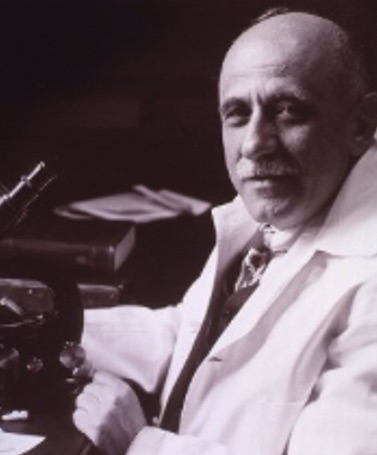 the understanding of the modern concept of autoimmune diseases, which he designated “collagen vascular disorders,” when he recognized a group of disparate entities as part of one disorder, systemic lupus erythematosus (SLE), Klemperer gave the intestinal cases to Oppenheimer, then studying in Klemperer’s department. Although Klemperer never wrote about this, some of his students thought it was he who initially understood that the condition we now call Crohn disease was unique.
the understanding of the modern concept of autoimmune diseases, which he designated “collagen vascular disorders,” when he recognized a group of disparate entities as part of one disorder, systemic lupus erythematosus (SLE), Klemperer gave the intestinal cases to Oppenheimer, then studying in Klemperer’s department. Although Klemperer never wrote about this, some of his students thought it was he who initially understood that the condition we now call Crohn disease was unique.
What about Crohn? Who was he? Burrill B. Crohn (1884-1983) was the grandson of a “religious, full bearded, orthodox Jew” who sought his fortune in the California Gold Rush of 1849. His father, Theodore, far less religiously observant, worked in the Pennsylvania oil industry and mining fields of Colorado before establishing himself as a merchant in Rockdale, a small town in Texas. When he came to New York for business, Theodore became smitten with the woman who would eventually be Burrill’s mother, who lived in Manhattan. He then sold the Texas business and eventually became a member of the New York and Petroleum Exchange. Burrill graduated from the College of Physicians and Surgeons of Columbia University and earned a difficult-to-obtain internship position at The Mount Sinai Hospital where he studied internal medicine and pathology. Crohn, a modest, unassuming man, cared for many patients in his long and successful career as a gastroenterologist, retiring at age 90 and dying at 99. He did not use the term “Crohn’s disease” either.
So what do we call this fascinating affliction?
“Alfred’s disease” would be grammatically appropriate but no one would understand the reason for the name. “Morgagni disease” might be scientifically appropriate since his is one of the first correlations of the clinical events with the findings at autopsy. One would find it hard to argue with “Dalziel disease” if we acknowledge that his paper was the first to describe the clinical events, the surgical findings and the gross and microscopic features. “Klemperer disease” would acknowledge the first full understanding of the nature of the disease, but he never wrote about his observations and conclusions and his connection to the disease is based on hearsay. Until a more scientifically precise name is applied, “Crohn disease” is the best choice. However, most of the medical profession, thus far, clings to the apostrophe “s,” failing to acknowledge the correct use of eponyms and, in almost every medical setting, except for a select few journals, “Crohn’s disease” remains the most widely used designation.
February 17, 2021 at 5:17 pm
Dr. Geller
You are indeed a great MAster, a brilliant professor. Your text opens our minds and illuminates the path to knowledge. Thank you
February 17, 2021 at 6:03 pm
Steve:
Beautifully written.
1. May I distribute this to the surgical residents?
2. Is there any truth to the rumor that Dr. Crohn did not wear a glove when performing rectal exams? I was told by a New York surgical resident that he felt that the glove diminished sensation to the fingers, thereby lessening the value of the exam.
Urban legend or medical fact?
Leo
===================
February 23, 2021 at 8:17 pm
Leo, please distribute as you please Thank you.
Don’t know the glove story specifically about Crohn but I believe it since many physicians of the time did not like to use gloves because (a) the gloves were much thicker than today’s gloves and (b) they felt that they could not feel as well. When I started my pathology residency in 1965 a few of my teachers did not use gloves except when dissecting the intestines and for many years, until the AIDS epidemic I followed their example. I became convinced that it was the better way to examine certain organs in order to not miss tiny lesions.
February 17, 2021 at 7:26 pm
Would not have thought I would be so engaged by a medical article but your wide-ranging coverage and compelling detail had me quite intrigued. The range of your scholarship is incredible!
February 18, 2021 at 1:01 pm
Thank you for another phenomenally interesting post! I had always been under the impression that Crohn, Ginzburg, and Oppenheimer were thought to have described a relatively new disease.
A couple of points:
I recall reading once that Dr. Crohn also objected to the use of his name for the disease. I think he preferred the term “regional enteritis,” though I have no idea what he called the disease when it was seen elsewhere in the GI tract.
My sense is that the Crohn’s and Colitis Foundation, formerly the National Foundation for Ileitis and Colitis, continues to play a vital role in the IBD community. Someone once told me that almost every American gastroenterologist who treats IBD patients is a member. Not sure, but I think the organization changed its name when the organization ceased to be a “national” foundation and became an international one. In any case, it is an organization with tremendous clout. You make a very convincing argument in favor of changing the name, but unless or until CCF admits the error, I am afraid that the name “Crohn’s Disease” is here to stay.
February 22, 2021 at 1:13 pm
Wow what a great essay! Thank you!
I plan to share this with a friend of mine who treats Crohn’s as a gastroenterologist at Mount Sinai.
November 12, 2021 at 7:44 pm
Thank you for composing this essay, Stephen. Your passion for medical history and pathology continues to impress me. Your writing has evolved into an art form. Please keep educating us.
Be well,